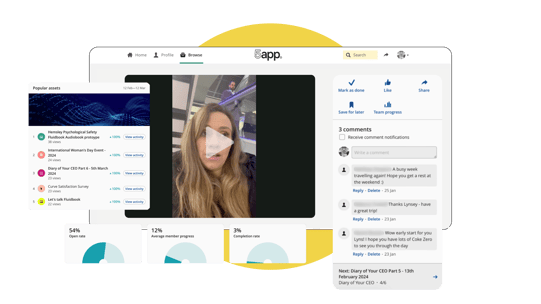“Wait, she’s moved teams?”
“Aren’t we using the blue logo anymore?”
“When did we open a Reykjavík office?!”
We all know what it’s like to work in a place where we never quite feel like we know what’s going on. That can be little things - like not knowing that the office coffee machine is broken - or big things - like not realising that your entire organisational goals have changed,
Ineffective knowledge sharing means your people miss out on job-critical information, which severely impacts operational efficiency, productivity and work performance. So if your employees aren’t keeping up with the flow of information, how can you get them back in the loop?
Why to prioritise employee comms
A lack of clear, transparent communication quickly leads to resentment, frustration, a lack of trust, disengagement and, ultimately, poor performance, which means that your business performance also takes a hit.
Employees wonder why they’re always the last to know what they need to know to do their jobs effectively, and they lose trust in the leadership team. Failing to connect your employees with the knowledge they need creates huge, far-reaching problems, from short-term time-wasting spent searching for the right information to long-term impacts such as employee retention and business stability.
In contrast, prioritising crystal clear comms and real-time knowledge sharing helps employees stay engaged, motivated and productive. They don’t need to trawl through systems for the latest information or rely on hearsay - they simply know what’s happening, when it’s happening, which obviously leads to better performance.
How to share business knowledge effectively
Bringing employees into the loop and raising awareness of what's going on across your business requires effective knowledge sharing. That covers everything from day-to-day news, process changes, personnel updates, industry developments and more.
In the absence of a dedicated internal comms role, employee comms will often fall to HR or the leadership team - but getting the point across quickly and clearly isn't as easy as it might look. If you often find your messages falling flat or not cutting through the noise, it's time for a rethink!
Prominent comms channels
A common mistake businesses make (yes, even in 2024) is sending out crucial messages via email. Your employees’ inboxes fill up fast, and a one-and-done email can quickly end up buried under a mountain of other messages, meaning it gets lost and ignored.
%20.gif?width=479&height=249&name=Platform%20Notifcation%20(inbox)%20.gif)
Equally, don’t quietly upload comms to your intranet and not tell anyone they exist. Instead, make it as easy as possible for people to access and engage with your comms. Put them on a platform everyone uses regularly, and then, most importantly, tell them about it. Automated notifications will alert your employees to any new comms, giving them a heads up about the latest goings-on in your business immediately.
Clear messaging
It’s not just what you say - it’s how you say it. Take a critical look at the way your leaders communicate - do they get to the point with clear, consistent language, or do they beat around the bush? This is especially common with difficult messages - many leaders drown the message in fluff, leaving employees unclear and confused.
If this is the case, it’s time to get comms training for your leaders to help them cut to the chase and explicitly set out how what they’re saying affects your people to avoid any doubt. This will stop the constant need to clarify your messages and help build trust between the leadership team and employees.
Looking to get started with better comms training this week? You could be up and running in days with 5app’s Plug and Play solution, featuring award-winning communications content by Hemsley Fraser. Take a look!
Highlight your key messages
What’s the tl;dr (too long; didn’t read) of each business communication you send out? While you may need to include a lot of context (for instance, when you’re explaining a complex business decision), it pays to pull out the key points that point to an action or impact for your employees.
Often it's as simple as rejigging your formatting. Think about placing key messages in bold or as bullet points at the top or bottom of the message - not everyone will read every word of every message, but you can at least make sure they get the edited highlights.

You can also look at your platform analytics to see what type of content resonates with people. If people prefer videos, get your senior leaders to record short clips on their phones (much like Hemsley Fraser's CEO). If they like podcasts, voice notes could be a better format for your internal comms. Don't be afraid to step away from standard text posts - it could be a game changer!
Track message engagement
Once you’ve hit send on your beautifully crafted message… then what? You may get a few likes or comments, but this is just the tip of the iceberg in terms of engagement. On Facebook, the average engagement rate per post (e.g. likes and comments) is a miniscule 0.064%, with Instagram clocking in at a ‘whopping’ 0.67%.
That’s a whole lot of people who are consuming content without (publicly) leaving a trace! But at work, it’s useful for your senior leaders to know who’s seeing what. That’s why it’s so useful to have a way to track engagement with every single message, whether that’s active (likes and comments) or passive (viewing the content).
5app content partner (and 5app customer!) Hemsley Fraser found this especially useful during the pandemic, as they could keep track of who was viewing what. For instance, for a single video, they could see that it had received 198 views (from a staff of 200) in the first 30 minutes of posting. Not only did this demonstrate the hunger for regular updates, but it also helped the CEO understand who had seen each message, whether or not they actively engaged.

Keep it relevant
The average office worker receives 121 emails per day - 121! And that’s not including the instant messages, WhatsApps and many other notifications they’ll inevitably receive - in other words, that’s a whole lot of messages. But how many of these are actually relevant to each person?
The more irrelevant messages we receive, the less importance we’ll place upon them, meaning people will start missing the messages that matter. Instead of overwhelming everyone with every update or piece of content, switch to targeted messages. 5app’s smart teams allow you to build custom audiences based on their membership of other teams, automating the way you communicate with different groups.
So for instance, you may want to send an update that is only relevant to your UK sales team - maybe about their commission structure. Using smart teams, you can select your UK audience, plus your sales audience, and as if by magic, it will create a UK sales team based on all members of the UK team and the sales team.
This helps you deliver targeted, relevant messages that only reach the people they matter to, while reducing the noise and digital clutter for everyone else.
